The Medit i900 represents an intriguing shift in Medit's market strategy. For years, Medit has been known as the company that democratized digital dentistry - their i500 and subsequent i600/i700 series revolutionized the scanner market by offering premium performance at budget-friendly prices. They effectively created the mid-tier scanner segment, forcing established players to rethink their pricing strategies and value propositions.
Now, with the i900, Medit is attempting something different. If their previous scanners were the reliable Hondas of the dental world - practical, efficient, and excellent value for money - the i900 represents their attempt at creating a Lexus. This scanner aims to compete directly with premium offerings from 3Shape, iTero and Dentsply Sirona while maintaining the innovative approach that made Medit a market disruptor.
The timing of this move is interesting. Released last year, Medit had established themselves as the value leader in digital dentistry, becoming the benchmark for price-to-performance ratio. Their excellent software platform and continuous development of free applications have set new standards for what users expect from scanner software. But can they successfully transition into the premium segment while maintaining their reputation for value?
As someone who has followed Medit's journey from their early days and tested every single scanner they've released, I'm particularly interested in how this premium offering fits into their broader strategy.
In this review, we'll examine whether the i900 successfully elevates Medit into the premium segment, or if they're better served maintaining their position as the value leader in digital dentistry.
As always, this review remains completely independent. While I maintain relationships with many companies in the digital dentistry space, this review was written without any input or influence from Medit. We don't sell Medit products at iDD, and our commitment to providing unbiased, reliable information to the dental community remains unchanged. Our goal, as ever, is to provide you with accurate, objective information to help inform your technology investments.
Enjoy the review.
Review At a Glance
The Medit i900 represents the company's first venture into the premium-cost scanner segment, It positions itself against established scanners while maintaining many of the aspects that made Medit successful - excellent software and scanning tech. While the price point is notably higher than typical Medit offerings, the scanner delivers significant improvements in ergonomics and scanning thanks to the larger scanning tips. Now it is 5k USD cheaper. Even better.
Pros:
Cons:
Medit Company Background
Medit's journey in digital dentistry tells one of the most interesting stories in our industry. Founded in 2000 and initially focused on industrial scanning, the company entered the intraoral scanner market in 2018 with the Medit i500. This scanner fundamentally changed the market landscape, proving that high-performance scanning didn't need to come with a premium price tag. This was at a time that economic scanners did exist, but they performed very terribly.
At roughly half the cost of existing scanners, the i500 forced established companies to completely change their pricing strategies. It was also one of the first scanners that did not have mandatory subscription fees when all else did. We have Medit to thank for pushing this onto all other companies.
The company's progression from the i500 through the i600/i700 series demonstrated their commitment to continuous innovation while maintaining competitive pricing. Each iteration brought meaningful improvements while keeping prices accessible, earning Medit a reputation as the value leader in digital dentistry.
Their approach to software development, particularly their practice of providing regular updates and new applications at no additional cost, has set new standards for what users expect from scanner companies. Even to this day, it is arguably the most feature-rich software on the market, although the large gap is closing with other companies following suit. Then came the i900.
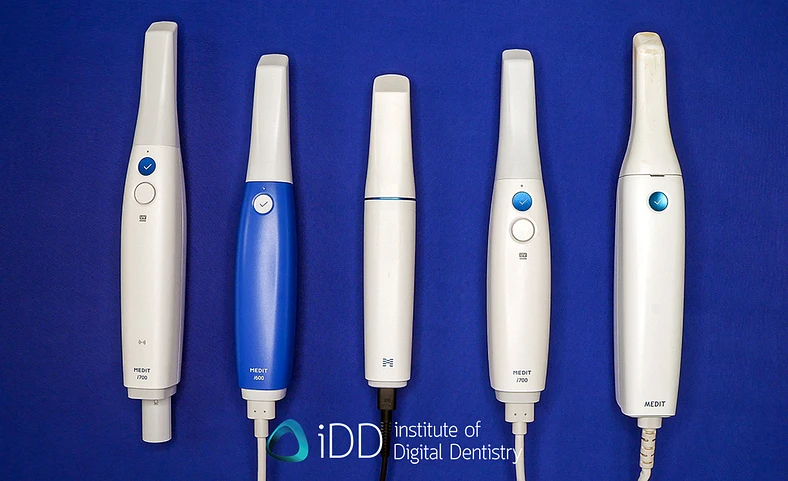
2024 marked a significant turning point for Medit with their acquisition by a private equity firm and the release of the i900. While this period created some uncertainty, the company seems to have maintained its development trajectory, with rumors of significant developments planned for 2025.
With the i900, Medit takes their biggest step yet - moving beyond their value-leader position to compete directly in the premium segment. This move comes at a time when they've already established themselves as a major player in digital dentistry, with their scanners being used in practices worldwide and their software platform setting industry standards for functionality and user experience.
Medit i900 Scan Speed
The i900 continues Medit's reputation of delivering excellent scanning capabilities, while introducing some notable improvements over their previous models. The most significant enhancement for the i900 comes from its larger scanning tip - following a market trend toward increased field of view.
This larger scan window enables faster data capture and more efficient scan flow, particularly noticeable in full-arch cases. This is the fastest scanner Medit has made.
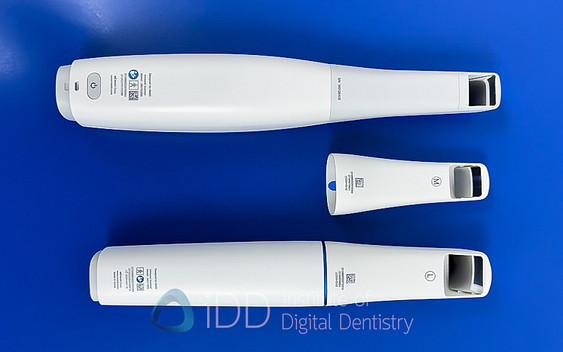
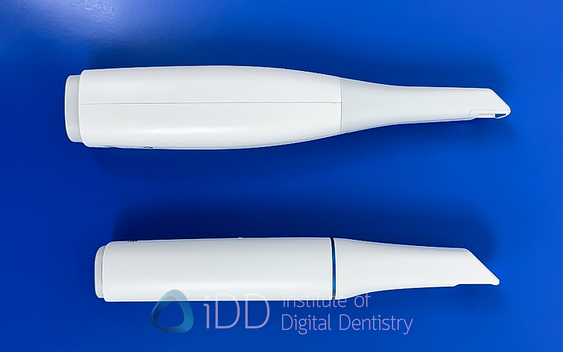
The i900 (bottom) has a significantly larger scanning FOV compared to all other Medit scanners.
In daily use, the scanner performs impressively, handling all scans efficiently and predictably. The increased scanning window not only improves speed but also makes the scanning process more forgiving. This is particularly evident when scanning edenutlous cases. This is another very fast and capable premium scanner.
One area where the i900 shows clear improvement over previous Medit scanners is its handling of challenging scenarios. Bloodly sites and edentulous scanning is noticeably improved thanks to the larger scanning tip, though TRIOS still maintains an edge in this department.
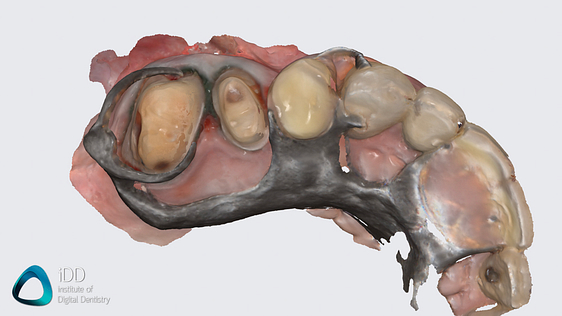
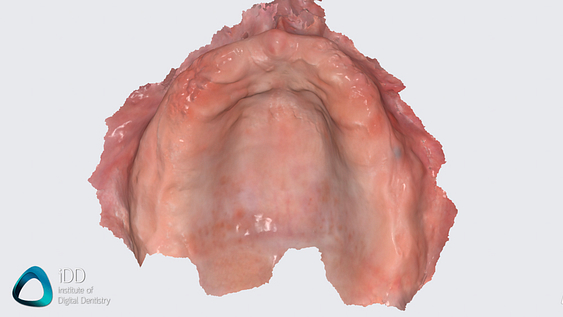
The scanner's AI capabilities are exceptional. They handle artifact removal very effectively, quickly filtering out unwanted data from cheeks, tongue, or dental instruments. The software is excellent giving you many options to control the AI.
Bite registration is fast and has been improved over the years. There is even a bite registration app to analyse the bite as this was something some users had issues with in previous generation Medit scanners. Although to be honest, dodgy bite registration is something that plagues a lot of scanners. It is a somewhere quirk that only a few companies have seemed to figure out. At least in this department, Medit have devoted an entire app to try combat this issue.
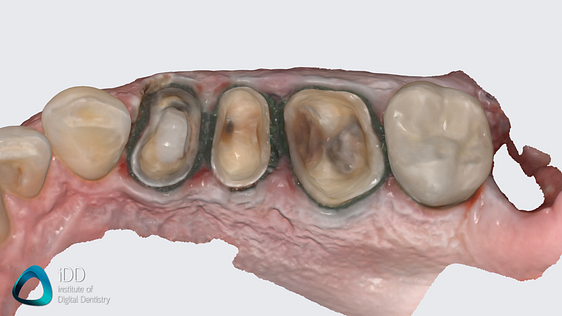
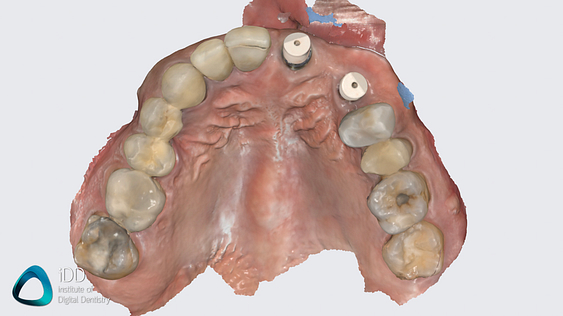
The i900 also quickly recovers its position when scanning is interrupted, it just feels very snappy. Post-processing times are fast, maintaining the workflow efficiency Medit users have come to expect.
While the i900 may not revolutionize scanning speed - as most modern scanners now perform at similar levels - it demonstrates clear refinement over previous Medit models while competing effectively with other premium scanners in the market. The larger field of view particularly benefits less experienced users, making the scanning process more intuitive and forgiving.
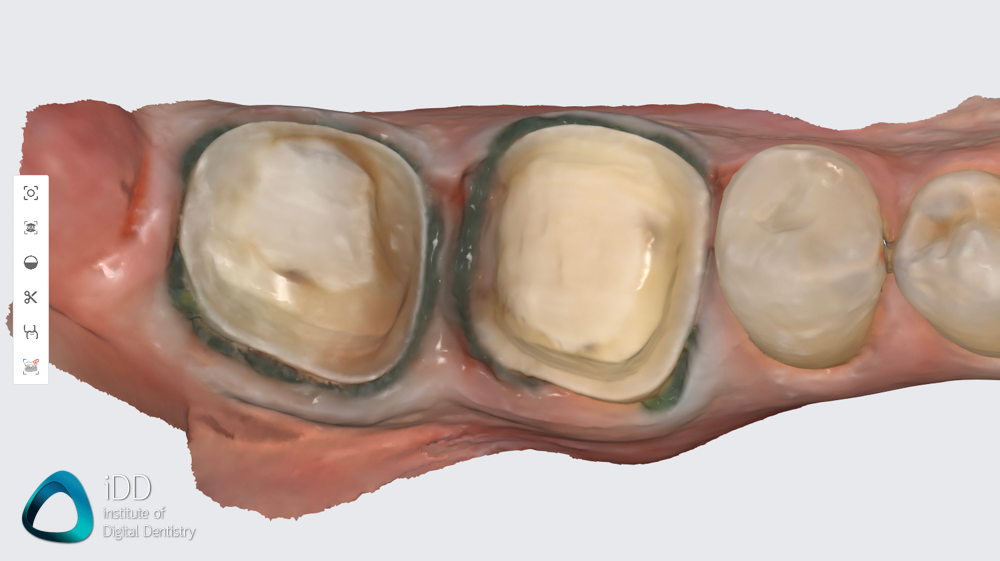
Design, Build Quality and Ergonomics
The i900 introduces some interesting design choices that set it apart not only from previous Medit scanners but also some market trends in general.
At 165 grams, it is the lightest scanner in Medit's lineup by a large margin and one of the lightest on the market. Interestingly, while many manufacturers are moving toward wireless scanners, Medit has chosen to return to a wired configuration for the i900, focusing instead on minimizing weight and optimizing size. Similar to what Shining3D has done with the Elite. Can we expect to see a wireless i900 in the future? Maybe.



The scanner's dimensions measure at 248 x 44 x 47.4 mm. The scanner is very ergonomic and small making it comfortable to use. When compared to other premium scanners like the TRIOS 5, Primescan 2 or iTero Lumina, the i900's compact form factor becomes even more impressive.

Can you spot the Medit i900 amongst all our scanners here at iDD?
Perhaps the most controversial aspect of the i900's design is Medit's decision to replace traditional buttons with capacitive touch panels. These touch-sensitive areas respond to various gestures - swipes, double-taps, and long presses - to control different scanner functions.
While innovative in concept, the implementation proves problematic in clinical use. The sensitivity of these panels often leads to unintended inputs, particularly challenging when wearing gloves. I found myself accidentally triggering the wrong function very often, swiping when intending to double-tap, or activating features unintentionally during scanning. It is actually very annoying.
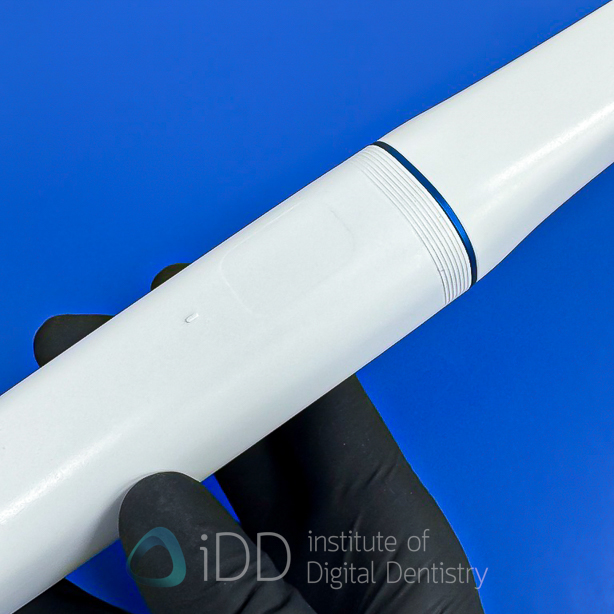

The touch controls of the Medit i900 - no buttons!
Fortunately, Medit has provided extensive customization options in the software to manage these touch controls. Users can disable specific gestures, limiting the touch panels to basic scan start/stop functionality. While this effectively solves the immediate usability issues, it also highlights that this particular innovation might have been better left on the drawing board. Traditional buttons, as found on previous Medit scanners and most competitors, offer more reliable and intuitive control during clinical procedures.
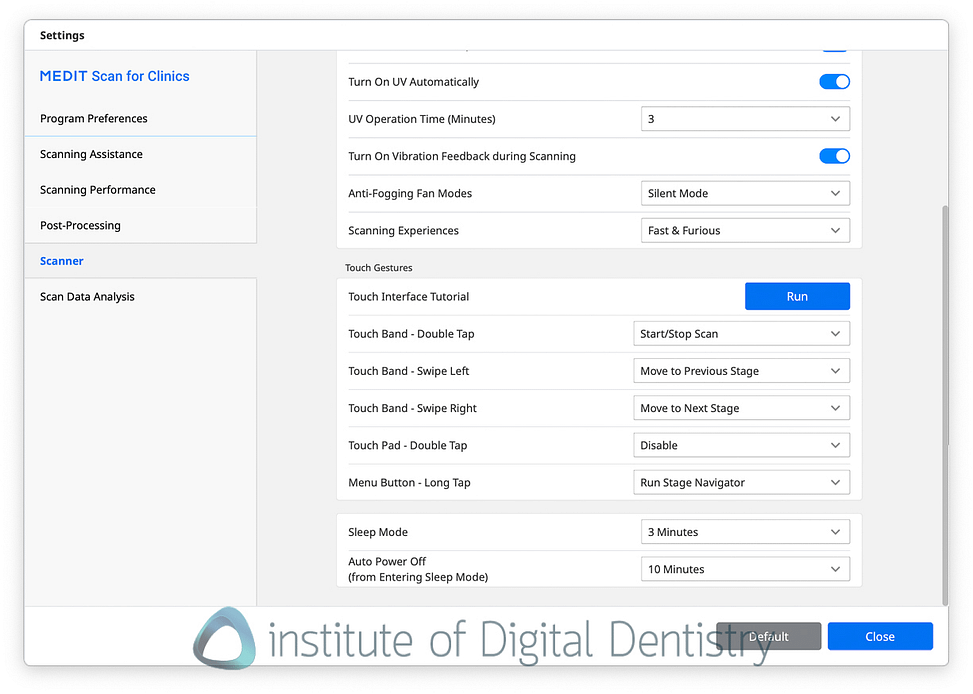
The decision to maintain a wired connection through USB-C is interesting, particularly as the market trends toward wireless options. The cable itself presents another curious design choice - its black color stands out awkwardly against Medit's traditional grey color scheme and the scanner's overall aesthetic.
I have no idea why they did not use a grey cable like every other Medit scanner. While the USB-C connection works flawlessly, providing both power and data through a single cable which is another market trend Medit established years ago, the black cable feels like an odd departure from Medit's usually cohesive design language.
Despite these quirks, the overall build quality is exceptional and clearly positions the i900 as a premium device. The materials used feel substantial and high-quality, with excellent fit and finish throughout. The scanner tips in particular are great, showing significant refinement in manufacturing quality compared to many other scanners which cheap out on this aspect.
The scanner also has a few LED lights at the back, which is a nice feature. Although more of a quality of life thing, it does give it a premium feel. These LED lights change colour based on scanner status - scanner tip on or off, scanning or not etc.
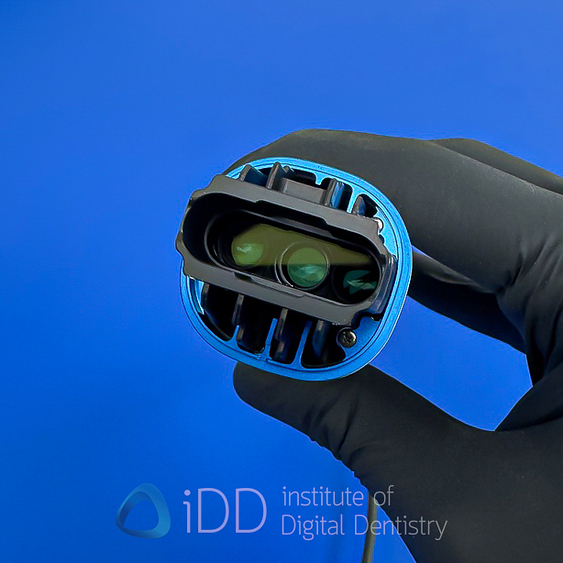

The company talks a lot about the scanner's balance which has been carefully considered, with weight distributed to reduce hand fatigue during extended scanning sessions. The scanner's lightweight design becomes particularly appreciated during longer procedures or full arch scans.
One thing that is interesting about the design is the depature from a power button like all other Medit scanners. Instead, like most scanners now, as soon as you plug it in, the scanner is on. And after a while if it is not used, it will go into a sleep mode. To wake it up simply pick it up. What is curious to me however, is how loud the fan is. I guess because it is such a small device, but the fan when the Medit i900 is not in sleep mode is very, very loud. Not to the point of being annoying but something that definietly stands out. You will see when you plug it in.
These design elements overall collectively showcase Medit's commitment to premium hardware development, even if some innovations like the touch controls don't quite achieve their intended goals, or the loud fan give a bit of an odd feel. The i900 demonstrates that reducing weight and optimizing size can provide excellent ergonomics without necessarily going wireless, though the touch control system suggests that sometimes traditional solutions might be preferable to innovation for innovation's sake.
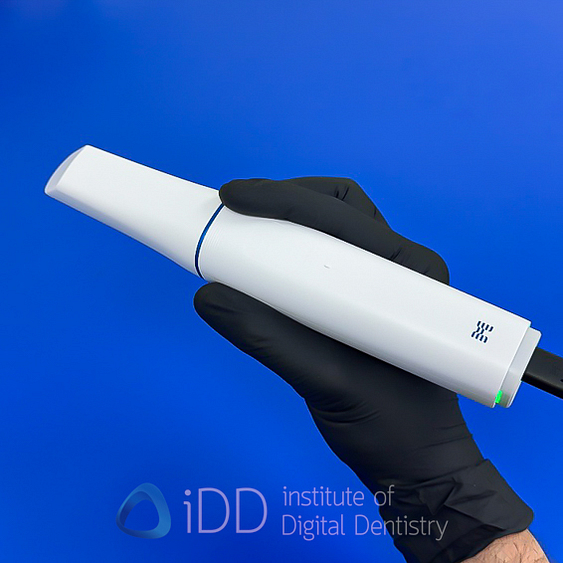

Medit i900 Scanner Tips
The i900 comes with four scanner tips in the box - two large sized and two medium size tips. Pediatric tips are also available and sold separately.
The standard tips feature a scanning window measuring 19 x 15mm, making them among the largest on the market. The scanning window dimensions represent a significant increase from previous Medit scanners (i700's 14 x 13mm) and reflect the current market trend toward larger scanning windows for improved scanning.
This larger field of view particularly benefits full arch scanning speed and handling of edentulous cases.
These tips can be autoclaved up to 150 sterilization cycles at 134 degrees Celsius which is a large number by todays standards. At approximately $70 USD per tip, the cost per patient for these tips remains reasonable compared to other premium systems. When factoring in the sterilization cycle limit, this works out to about $0.47 per patient - a modest running cost for a premium scanner.


Medit i900 Calibration
The i900 Medit's approach to calibration is kind of standard - requiring it to be done every 12 weeks or 500 scans, whichever comes first. The system uses the familiar Medit calibration tool design - a simple grey cylinder that's been common across their scanner line. Although not interchangeable between different scanner models.
There's no separate color calibration required like TRIOS 3 / CORE and a few other scanners, simplifying the maintenance routine. The process takes approximately 2-3 minutes to complete.
The software provides clear notifications when calibration is due and guides users through the process with on-screen instructions. While the scanner can still be used when calibration is overdue, it's not recommended as it may affect scanning accuracy.
The calibration tool itself is also well-built and comes with a protective case to prevent damage to the reference surfaces. While many manufacturers are moving toward calibration-free systems, Medit maintains that regular calibration provides an important quality control measure, ensuring consistent accuracy over time.
I personally think they will go calibration-free with time also. Seems to be a market trend.
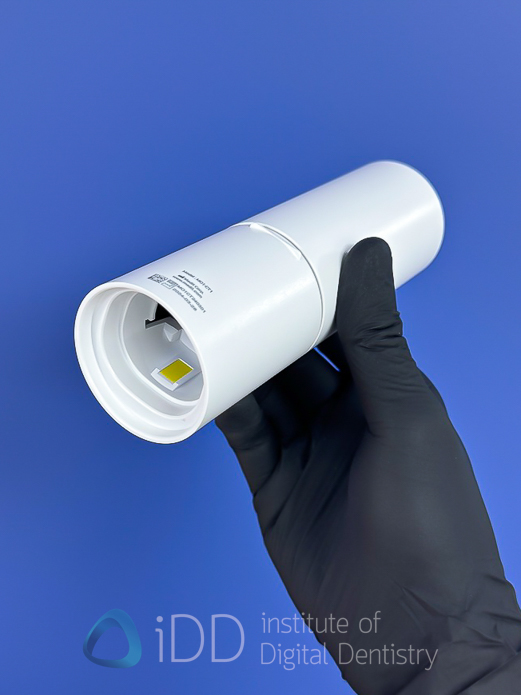
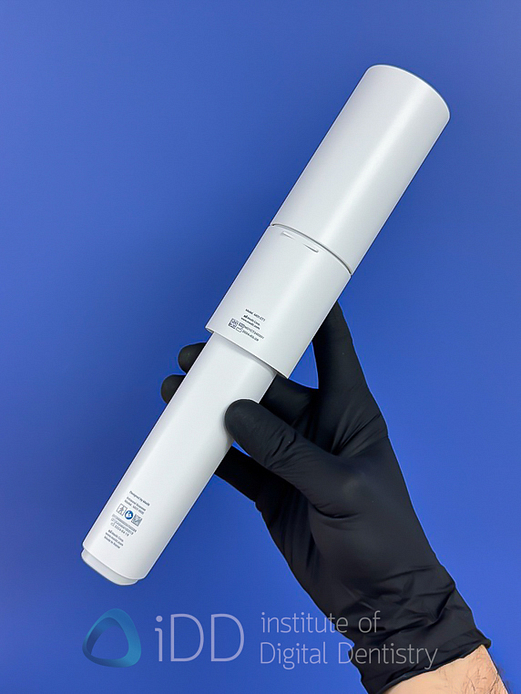
Medit i900 Accuracy
As the i900 is relatively new to the market, peer-reviewed literature specifically validating its accuracy is still emerging. However, early studies and our extensive in-house testing suggest this scanner represents a step forward in Medit's scanning accuracy capabilities. Medit have always provided high-accuracy scanners, and this is the best they make.
In our clinical testing, comparing scan data between the i900 and every other scanner, we observed notably consistent results. The scanner excels in accuracy. It's larger field of view and enhanced scanning algorithms seem to reduce cumulative errors that can occur over longer scanning distances. When comparing mesh data between various scanners using comparison software, the i900 demonstrated excellent accuracy.
For practices requiring highly accurate digital impressions, whether for single units or complex full-arch cases, our testing suggests the i900 delivers the precision needed for even the most demanding clinical applications. This level of accuracy, combined with its efficient scanning workflow, positions the i900 as a genuine competitor in the premium scanner segment.
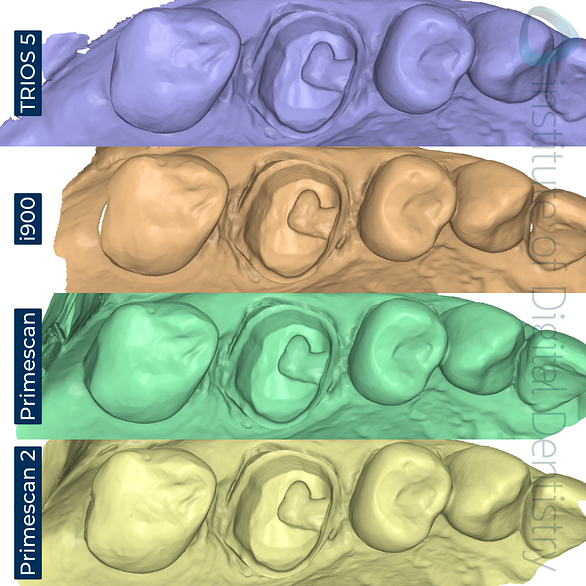
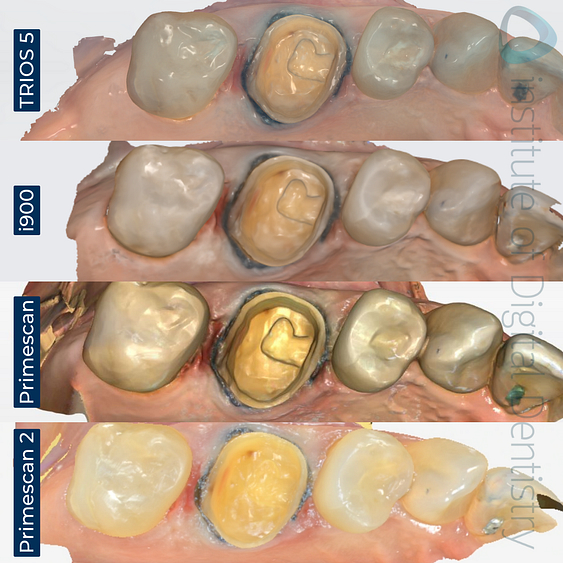
Check out all our iDD Compares Articles Here. We compare all scanners objectively and clinically.
Medit Software Ecosystem
Medit's software platform represents one of the most comprehensive ecosystems in digital dentistry. It is seriously amazing.
While other manufacturers often treat software as an additional revenue stream or provide the bare basics, Medit continues to provide their entire suite of applications and regular updates at no additional cost, setting a new standard for what users should expect from their scanner investment.
Medit is responsible for a market shift they caused a few years ago that compelled numerous other companies to integrate additional apps and features into their software.
Their software comes as 2 parts - Medit Link and Medit Scan for Clinics (or Labs if you use a Medit Lab scanner).
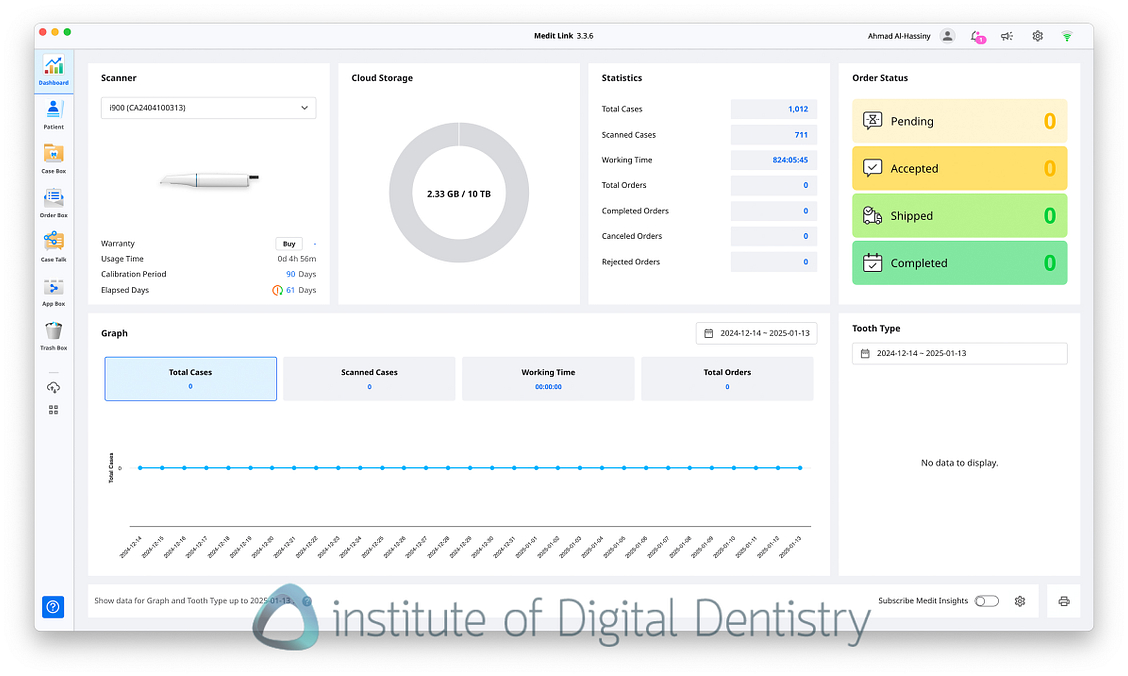
Medit Link Platform
Medit Link serves as the foundation of their digital ecosystem, but calling it scanner software would be an understatement. It's a comprehensive digital dentistry platform that manages everything from basic scanning to complex digital workflows and practice analytics.
The platform's strength lies in its integration capabilities. Medit has developed partnerships with virtually every major player in digital dentistry. They have over 100 integrations from PMS, imaging and diagnostic software, to CAD and CAM software. It is likely one of the most (if not the most) of any scanner software.
Their software integrates directly with 3Shape Dental System, maintains full exocad compatibility for design workflows, and connects seamlessly with major lab management systems. The platform also offers direct integration with leading 3D printer manufacturers and popular milling machines, while supporting various clear aligner planning software systems.
The user interface reflects years of refinement, organizing complex functionality into intuitive workflows. The dashboard provides real-time practice analytics, case tracking, and workflow management tools. Case organization is particularly well thought out, with advanced filtering and search capabilities that make managing large numbers of cases efficient.
They even just launched an app - the "MEDIT M mobile app" which basically is like having your Medit Link software on your phone. You cannot scan from your iPhone but you can get real-time notifications on lab work, manage cases via your mobile, view scans and communicate with labs. This is similar to the (excellent) 3Shape phone app and Medit did a great job with this.
Overall, Medit Link is one of the best scanner software on the market. Easily.
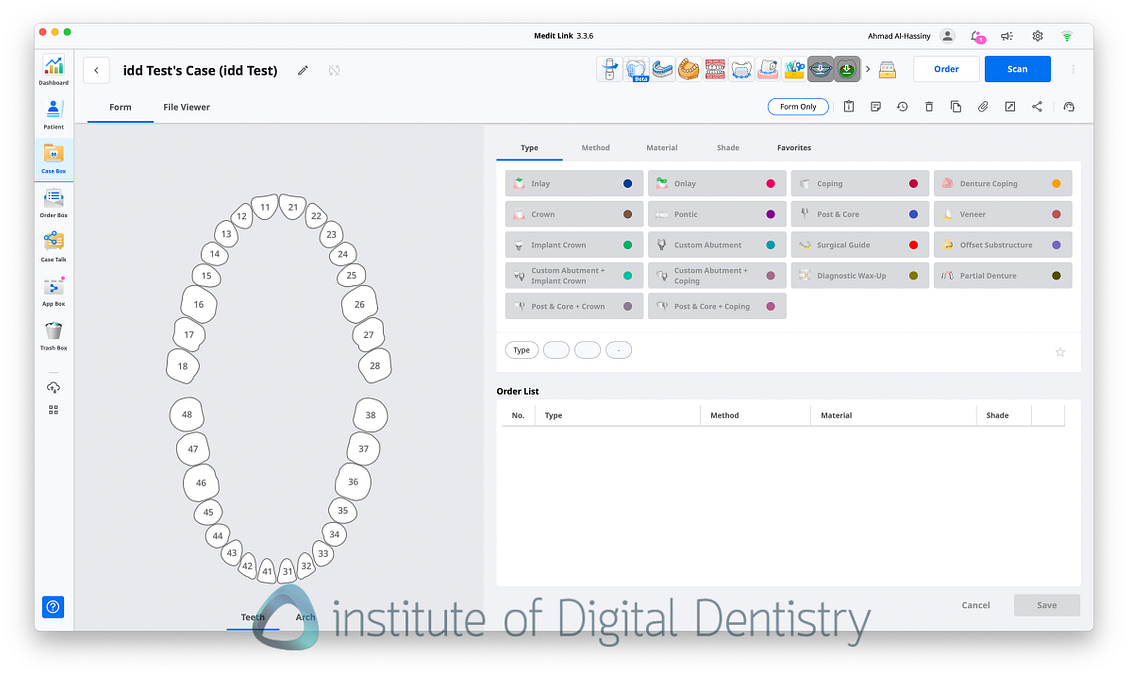
Medit Scan for Clinics
The scanning software itself, Medit Scan, is opened when you want to start scanning. It demonstrates impressive sophistication while maintaining ease of use. Each clinical workflow has been carefully optimized. The crown and bridge workflow includes automatic margin detection while providing multiple preparation scanning modes and advanced occlusal analysis tools.
The implant workflow is equally comprehensive, offering a extensive scan body library and multiple implant scanning protocols. The software can automatically detects scan bodies and provides verification tools for implant position accuracy.
For removable prosthetics, specialized edentulous scanning modes and denture duplication tools make complex cases more manageable.
Basically the software does it all very well. And there are a huge range of tools a features for editing the scans and controlling the AI that filters the scan data. It is a very flexible and capable software.
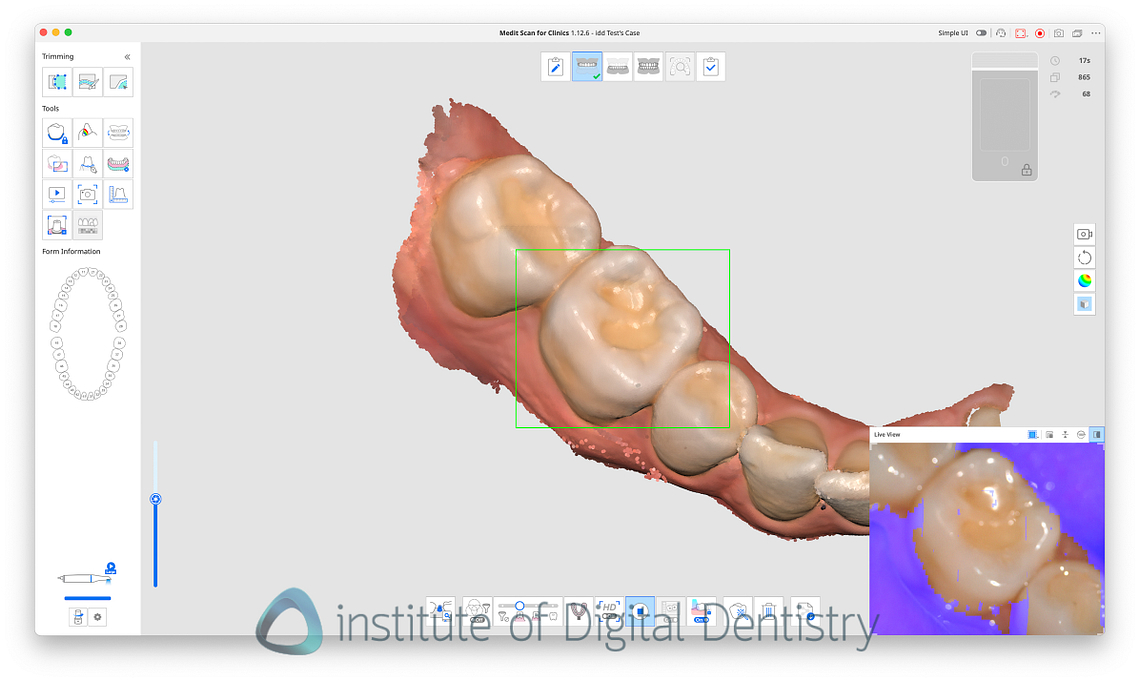
Applications Suite
Medit's app ecosystem has grown significantly, now offering comprehensive tools for various clinical needs.
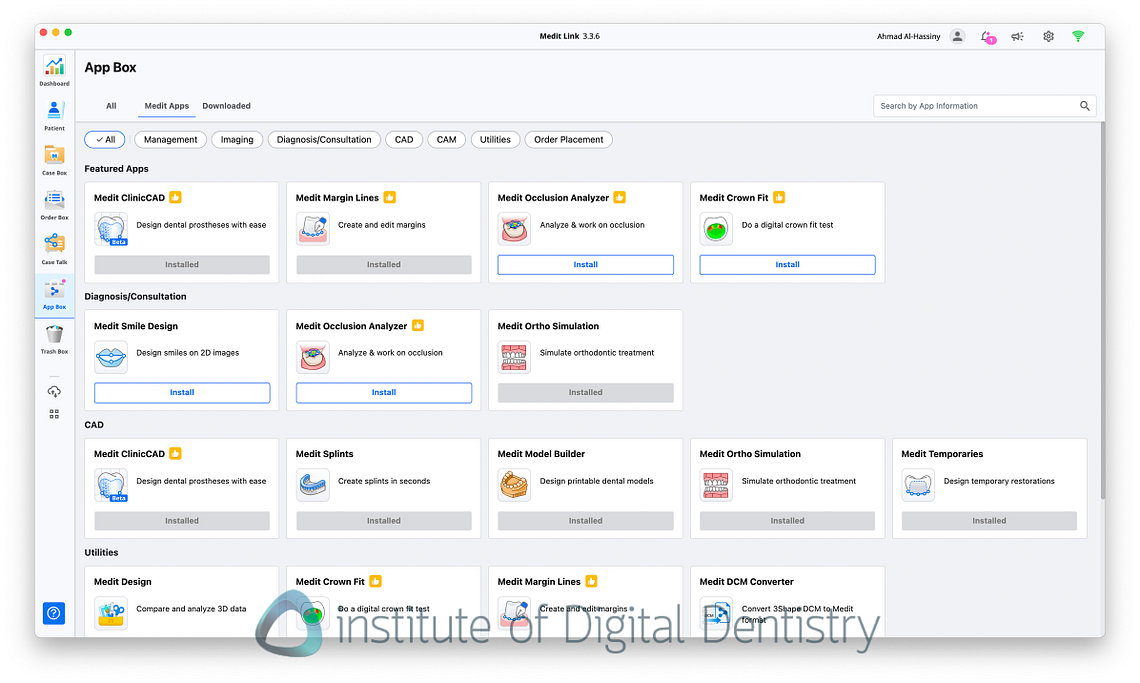
The Model Builder has become the gold standard in digital model creation, offering everything from basic model generation to complex articulator integration. The software streamlines the preparation of files for 3D printing, handling hollow model optimization and automated support generation.
Medit Design provides full CAD capabilities directly within Medit Link. Users can design everything from single crowns to bridge frameworks, with tools for creating temporary restorations and split files for printing. The material selection system optimizes designs based on manufacturing method and material choice. You literally get a CAD software for free with Medit and its pretty good. A great way for clinicians to dip their toes into chairside CAD and learn the ropes. For free!
The Ortho Simulator leverages AI for automatic tooth segmentation and movement prediction, while providing comprehensive IPR planning tools. The system can visualize treatment outcomes and track progress throughout treatment.
Similarly, the Crown Fit application offers advanced prosthetic verification tools, analyzing margin fit and internal adaptation while documenting results for quality control.
Smile Design takes aesthetic planning to a new level by integrating facial scanning capabilities with dental design tools. The software automatically calculates ideal tooth proportions while allowing real-time adjustments to match patient expectations. Treatment proposals can be easily shared with patients, labs, or referral doctors through the Medit Link platform.
Medit Compare serves as a sophisticated monitoring tool, enabling detailed tracking of changes over time. Whether monitoring tooth wear, orthodontic movement, or periodontal changes, the software provides precise comparison tools and documentation capabilities. The automated alignment of different time points makes monitoring changes straightforward and efficient.
The recently introduced AI Suite brings artificial intelligence to diagnostic capabilities. The software can detect caries, calculus, and other pathologies, creating detailed reports for patient education and documentation. While these AI features are still evolving, they demonstrate Medit's commitment to pushing technological boundaries.
Consultation apps like Medit Talk and Patient Monitoring transform the scanner into a powerful patient communication tool. These applications help visualize treatment plans, track progress, and improve case acceptance through clear, engaging presentations of digital data.
and many more. The company has a lot of other apps and just recently partnered with Progressive Orthodontics to provide specific apps for those providing orthodontic care. The entire suite and app library is excellent.
Medit Cloud Features and Connectivity
Medit Link's cloud integration goes beyond simple file storage and this is another thing the company pioneered - cloud storage and live syncing for intraoral scanner software.
The platform enables real-time collaboration with laboratories, instant case sharing between practice locations, and automated backup of all scan data. The system maintains HIPAA compliance while providing flexible access to case data from any connected device.
Lab communication is streamlined through the platform. Cases can be submitted with detailed prescriptions. Real-time chat and case status tracking keep all parties informed throughout the fabrication process. The new mobile app makes all of this even better.
What truly sets Medit's software platform apart is their aggressive development cycle. Monthly updates regularly introduce new features and refinements, all included without additional subscription fees. This commitment to continuous improvement has helped establish Medit as a software leader in digital dentistry, even as they move into the premium hardware segment with the i900.
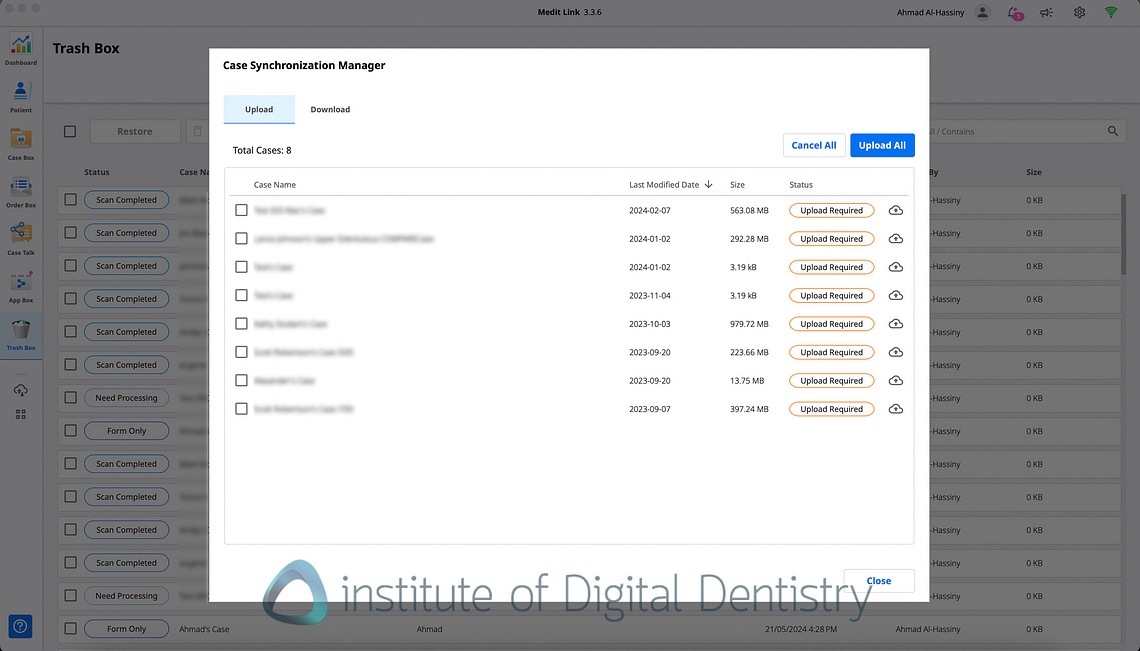
Medit i900 Price + Ongoing Costs
The Medit i900 represents a significant shift in Medit's pricing strategy as they enter the premium scanner segment.
At launch, the scanner was priced at $24,500 USD, but at the start of 2025 Medit has brought down the price to $20,999 USD with a packaged laptop, or $18,999 USD for the scanner only. That is a five thousand dollar price drop. Wow.
This competitive price is much better for the i900 than the launch price in my opinion. It did feel initially the i900 was priced too high. This new pricing strategy is particularly interesting when viewed within Medit's complete scanner lineup. The company now offers a range of options:
- i600 at $10,500 USD (entry-level)
- i700 at $13,500 USD (mid-range)
- i700 wireless at $15,500 USD (mid-range wireless)
- i900 at $18,999-20,999 USD (premium)
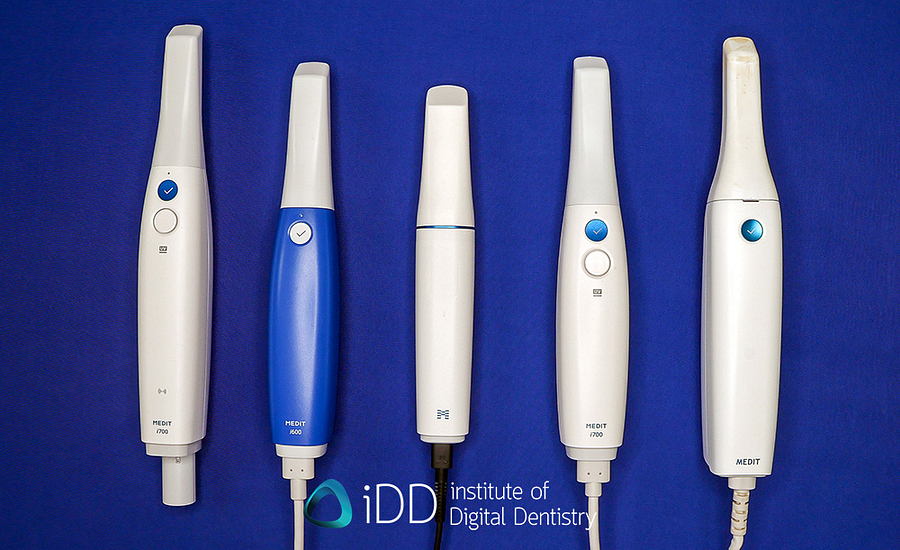
Running costs remain reasonable for a premium scanner. The scanning tips, which can be autoclaved up to 150 times at 134 degrees Celsius, cost approximately $70 USD each. With four tips included in the initial package (two standard and two medium size), practices can manage their initial autoclave rotation effectively. When factoring in the sterilization cycle limit, the cost per patient remains competitive at around $0.47.
In 2024, Medit faced noteable community backlash when they increased their cloud storage fees, moving away from their previous $0.99 per month for 10 TB cost, up to $9.99. It is still very cheap for 10 TB frankly - go look at DS CORE prices or 3Shape pricing for their cloud storage, but the increase from dirt cheap $0.99 caused an outroar in the community.
The basic 2 GB tier still remains completely free and provides OK storage for small practices, with paid tiers offering reasonable rates for higher-volume users. Once again, despite the controversy, these storage costs are minimal compared to the subscription fees charged by other premium scanner manufacturers.

Medit maintains their subscription-free approach for all scanner functionality and applications with the i900. All software features, applications, and regular updates are included without additional fees. The only on-going cost is scanner tips and the premium cloud storage if you want to use it.
For practices opting for the scanner-only package, expect to invest $2,000-3,000 in a suitable laptop meeting the recommended specifications. However, the complete package including the laptop offers better value for practices wanting a turnkey solution.
This pricing structure positions the i900 as a mid to premium scanner. While it represents Medit's highest-priced scanner to date, at its reduced price point it maintains a competitive price advantage compared to other premium scanners in the market which often exceed $20,000-25,000 USD.
Conclusion
The Medit i900 represents a fascinating evolution in Medit's journey from market disruptor to premium competitor.
At its newly adjusted price point of $18,999 USD (down from the original $24,500), the scanner delivers impressive performance while trying to maintain Medit's value-focused philosophy, even in the premium segment.
Is this big drop in price in 2025 due to market pressure and weaker than expected sales? Nevertheless, the i900 brings several notable strengths to the table compared to previous Medit scanners. At 165 grams, it's one of the lightest scanners available, and its larger scanning tips provide excellent performance, particularly in challenging scenarios like edentulous scanning.
The scanning speed and accuracy compete effectively with other premium offerings. In our testing the Medit i900 is one of the most accurate scanners on the market. While Medit's comprehensive software platform continues to set industry standards.
However, the i900 isn't without its quirks. The touch-sensitive control panels, while innovative in concept, prove frustrating in clinical use in my experience, though thankfully these can be largely disabled through software settings. The black USB-C cable seems an odd departure from Medit's usual design language, and some users might question the decision to maintain a wired connection in a market trending toward wireless options.
The software ecosystem remains one of Medit's strongest assets. Their aggressive development cycle, comprehensive app suite, and extensive integration capabilities continue to impress, even as competitors race to catch up. While the recent introduction of increased cloud storage fees caused some community backlash, the overall software package remains subscription-free and highly competitive.
The i900 demonstrates that Medit wants to compete in the premium segment while maintaining their value proposition. While some design choices might raise eyebrows, the fundamental scanning performance, software capabilities, and newly adjusted pricing make it a compelling option in the premium scanner market.
This is an excellent scanner. The i900 successfully elevates Medit's hardware offering to match their software excellence, even if some innovations don't quite hit their mark.
Evaluation Ratings
Scanning Speed
Scanning Flow
Scanner Size
Ease of Use
Scanner Software
Investment Cost
Additional Features
Wireless Scanner
Caries Detection
Not instrinsic in the scanner itself but via an app and AI diagnostics.
Software Apps
A huge number of different apps
CAD/CAM Software
Medit ClinicCAD - free.
Subscription Requirements
Optional subscription for increased cloud storage
Autoclavable Tips
150 times per tip

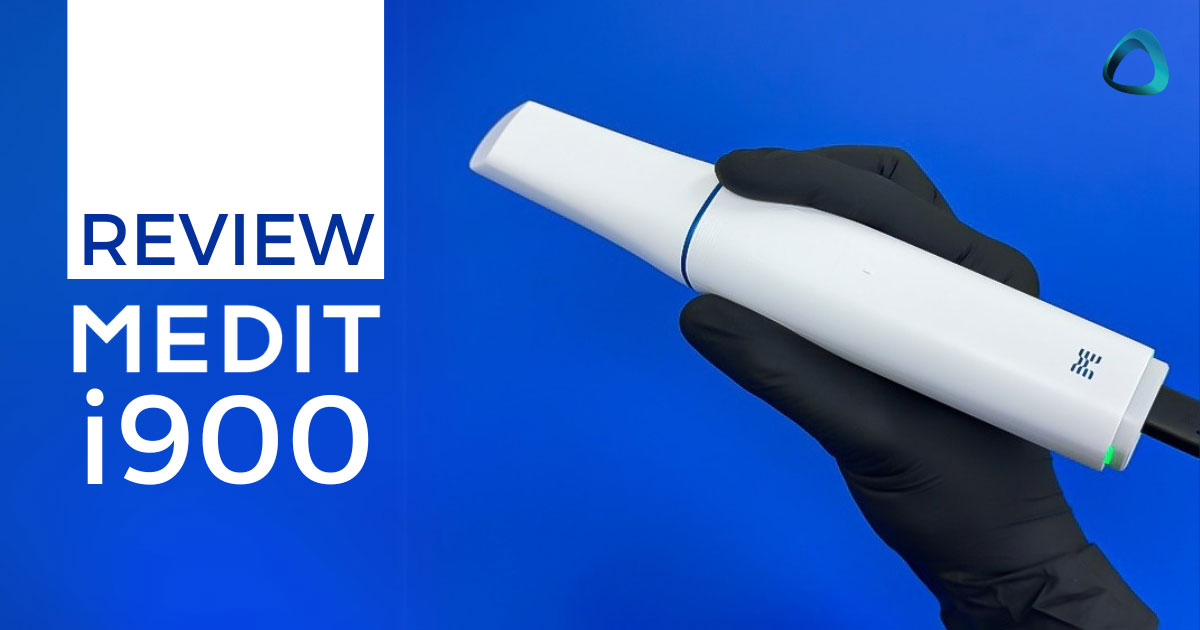
Did you get the chance to try the i900 classic (non-touch) version? I’m generally not a fan of anything touch based and I would have the same concerns about finicky touch controls as you mentioned in the review.
Hey Jeffrey. Thanks for your question. I have tried the i900 Classic version. I prefer it and it completely comes down to your preference.
I will be doing an updated review on the classic version but it is basically the same exact scanner. So everything in this review applies. But with no touch controls.